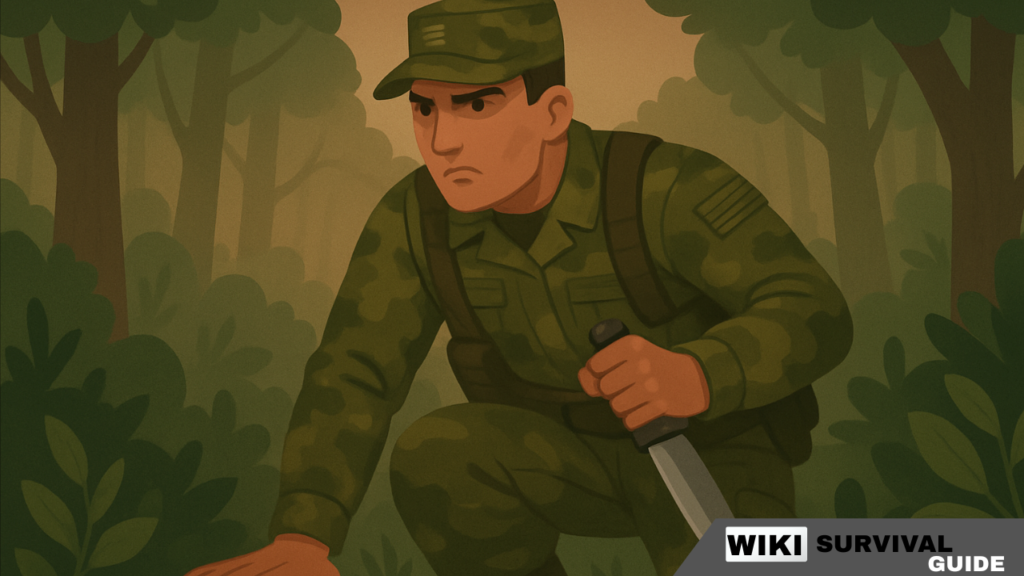By WikiSurvivalGuide Team | May 2, 2025
The U.S. military survival guide equips you with battle-tested techniques to conquer any wilderness challenge. Informed by U.S. military doctrines like FM 3-05.70, WikiSurvivalGuide.com delivers essential skills for 2025—shelter, water, fire, food, navigation, first aid, and signaling. Whether facing a storm or a remote trek, these strategies ensure you survive and thrive with resilience.

Why Military Survival Skills Are Vital
U.S. military survival training is designed for the toughest scenarios—jungles, deserts, or arctic wastes. These techniques, honed through real-world missions, emphasize resourcefulness, mental toughness, and minimal gear. In 2025, with extreme weather and growing outdoor pursuits, mastering these skills is critical for hikers, preppers, or anyone caught in an emergency. This guide distills military wisdom into practical steps, empowering you to face the wild with confidence.
Quick Survival Overview
Military survival hinges on seven pillars:
- Shelter: Build a lean-to or debris hut to shield from elements.
- Water: Locate and purify streams or rainwater.
- Fire: Start with tinder and sustain for warmth or signaling.
- Food: Forage plants or trap game safely.
- Navigation: Use stars or improvised compasses to stay on course.
- First Aid: Treat wounds or hypothermia to stay functional.
- Signaling: Use smoke or mirrors to attract rescuers.
Essential U.S. Military Survival Techniques
Master these techniques to survive any environment. Each step is grounded in military efficiency and adaptability.
Building Shelter
Shelter protects against hypothermia and exhaustion. Military methods prioritize speed and local resources.
- Select a hazard-free location, away from falling branches or flood zones. Use natural cover like caves.
- Gather branches, leaves, or snow. Pine needles offer excellent insulation.
- Build a lean-to by propping a branch against a tree at a 45-degree angle, covering with debris.
- Insulate with grass or leaves to trap heat. Keep the entrance narrow.
- Blend with mud or foliage for stealth if needed.
- Start construction early to avoid darkness or cold exposure.
- Test for stability by shaking; reinforce during storms.
Securing Water
Water is non-negotiable—dehydration kills in days. Military survival ensures clean, reliable sources.
- Find flowing streams or collect dew from leaves. Avoid stagnant water.
- Boil for one minute or filter through cloth to remove debris.
- Funnel rainwater using leaves or a tarp into a container.
- Sip slowly to conserve supplies. Don’t eat without drinking.
- Use bark or hollow logs as makeshift containers.
- Dig near vegetation in dry areas for groundwater.
- Stay upstream of animal waste to avoid contamination.
Starting a Fire
Fire provides heat, cooking, and signals. Military techniques ensure success in harsh conditions.
- Collect dry tinder—grass, bark, or pine needles. Store in a dry place.
- Clear a 3-foot circle, using rocks to contain flames. Avoid wet ground.
- Spark with flint, a lens, or a bow drill for friction.
- Add twigs, then larger branches in a teepee shape for airflow.
- Shield with a windbreak or build under cover in rain.
- Smother with dirt to extinguish safely.
- Add green leaves for smoky signals during rescue attempts.
Finding Food
Food sustains energy, but military survival ranks it below water and shelter. Focus on safe sources.
- Identify edible plants like dandelions or cattails. Avoid milky sap.
- Set snares for small game like rabbits. Check traps daily.
- Fish with a sharpened stick or net in shallow waters.
- Cook all meat thoroughly to kill parasites.
- Test plants by rubbing on skin to check for reactions.
- Dry meat or berries over fire to preserve.
- Skip unknown mushrooms or berries to avoid poisoning.
Navigating Terrain
Navigation keeps you oriented, guiding you to safety. Military methods use natural and improvised tools.
- Track the sun (east at sunrise) or Polaris (north at night).
- Magnetize a needle, float it on water to find north.
- Mark trails with notched trees or rock piles.
- Follow ridges or valleys for easier travel.
- Count steps (100 per 100 meters) to estimate distance.
- Use animal trails, which often lead to water.
- Check landmarks regularly to stay on course.
Administering First Aid
First aid prevents minor injuries from escalating. Military training focuses on quick action.
- Rinse wounds with clean water; cover with a cloth.
- Apply pressure to stop bleeding. Elevate if possible.
- Cool burns with water for 10 minutes; don’t pop blisters.
- Splint fractures with sticks and cordage.
- Treat shock by keeping warm and elevating feet.
- Warm hypothermia victims slowly with blankets or fire.
- Carry bandages and antiseptic wipes for emergencies.
Signaling for Rescue
Signaling ensures rescuers find you. Military methods maximize visibility.
- Build three fires in a triangle, a universal distress signal.
- Add green leaves for thick daytime smoke.
- Flash mirrors or metal to reflect sunlight.
- Shout or whistle in groups of three.
- Create “SOS” with rocks or logs in open areas.
- Use bright clothing to stand out.
- Signal only when rescue is likely to conserve energy.
Why Military Techniques Excel
U.S. military survival skills are forged in extreme conditions, prioritizing efficiency and adaptability. Unlike civilian methods, they integrate stealth, rapid decisions, and minimal tools, making them ideal for 2025’s challenges—wildfires, floods, or remote stranding. These techniques build mental and physical resilience, ensuring you’re ready for any crisis.
Survival Techniques Table
Compare techniques for quick reference:
| Technique | Core Steps | Priority |
| Shelter | Select site, build lean-to, insulate | High (prevent hypothermia) |
| Water | Locate, purify, sip slowly | Critical (avoid dehydration) |
| Fire | Use tinder, build teepee, signal | High (warmth, rescue) |
| Food | Forage, trap, cook thoroughly | Medium (energy maintenance) |
| Navigation | Track stars, mark trails, plan routes | High (stay oriented) |
| First Aid | Clean wounds, stabilize, treat shock | Critical (prevent infection) |
| Signaling | Use fires, mirrors, create SOS | Medium (rescue scenarios) |
Tips for Mastering Military Survival
- Practice skills like fire-starting in safe settings to build confidence.
- Carry a compact kit: knife, flint, cordage, and bandages.
- Stay calm to avoid energy-wasting panic.
- Prioritize shelter and water over food for survival.
- Adapt techniques to your environment (e.g., snow shelters).
- Study local wildlife and weather for preparedness.
- Signal strategically to conserve energy.
- Rest to maintain stamina for demanding tasks.
Conclusion
The U.S. Military Survival Guide: Essential Techniques for 2025 delivers proven skills to conquer any crisis. From lean-tos to lifesaving signals, these military-inspired methods ensure you’re ready for the wild. WikiSurvivalGuide.com empowers you to survive with confidence and resourcefulness.Disclaimer: For informational use only. Practice survival techniques responsibly and seek professional training for advanced skills.
FAQs
Q: What is a U.S. military survival guide?
A U.S. military survival guide teaches techniques from military training to survive emergencies, covering shelter, water, fire, food, navigation, first aid, and signaling.
Q: Who can benefit from military survival skills?
Hikers, campers, preppers, or anyone facing wilderness or urban emergencies can use these adaptable techniques.
Q: Are these skills safe for beginners?
Yes, with practice. Start with basics like fire-starting before tackling snares or navigation.
Q: How do military survival tactics differ from civilian ones?
Military tactics emphasize minimal gear, stealth, and rapid response, designed for extreme conditions.
Q: What’s the most critical survival need?
Clean water is vital, as dehydration can kill within three days.
Q: Can these techniques work in urban disasters?
Yes, first aid, signaling, and resource conservation apply, though navigation may vary.
Q: What gear do soldiers carry for survival?
Soldiers carry knives, flint, cordage, containers, and first aid supplies for versatility.
Q: How long can you survive without water?
About three days, though heat or exertion may shorten this. Prioritize water sourcing.
Q: How do I practice military survival safely?
Test skills in controlled environments, like your backyard, and study local conditions.
Q: Why are military techniques relevant in 2025?
Extreme weather and outdoor exploration make these resilient, adaptable skills essential.




Leave a Comment